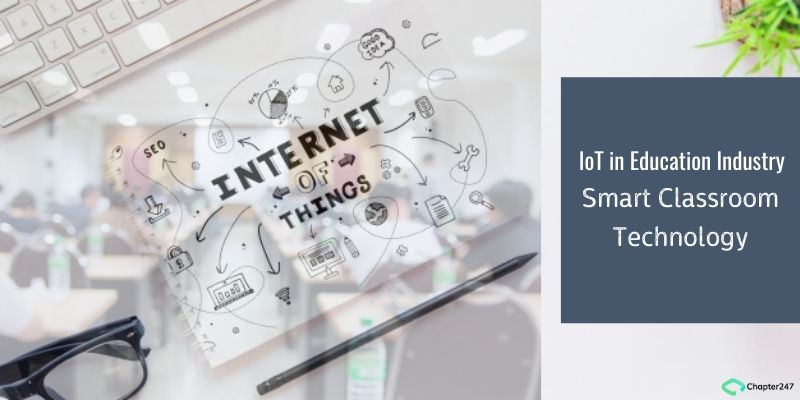Smart classroom technology- IoT in Education Industry
IoT for schools has been a great endowment to the education industry like it has been for many industries. IoT in the education industry has expanded boundaries and also created many learning opportunities by providing a competitive set of tools to educators thereby smoothening the process of learning.
A popular news broadcaster categorically mentioned that California in 2009 passed a law that demanded every college textbook to take the electronic form by 2020. Florida also two years later passed yet another law that demanded public schools to convert their textbooks into digital versions. Many nations are now resorting to smart classes to embrace the latest technology trends for the educational industry. Among these technology trends, IoT is considered the best of the lot.
What is the Internet Of Things?
IoT refers to the zillions of all around the world that are connected to the internet. It finally boils down to the collection and sharing of data. With technological advances, digital intelligence is the new key. Devices are not as dumb as they used to be because of the newfound capability of communicating with real-time data without any human involvement. It acts as a bridge between the virtual digital world and the real physical world.
Key applications of IoT in the education industry
Smart Attendance tracking system
The colossal benefits of having a smart tracking attendance ecosystem are:
Data redundancy has reduced considerably with 99% of the data being trustworthy.
Smart-tracking the location of the student is now just a click away.
IoT powered biometric devices have helped institutions to strengthen their security.
Students are more regular to classes.
Report generation has become way easier because of the benefit of downloadable reports.
Usage of Smart Boards
Many educational institutions who have embraced technology for schools wholeheartedly have imbibed the use of smart boards. They are highly interactive and make learning a fun experience. You can well dissect an animal without actually dissecting it thanks to the smart boards that make learning a real-time experience. Also, your physical books also have a shelf-life because the rate at which information is changing, updating the textbooks might not always be possible, but learning composition on these IoT devices can be updated as and when the need arises.
Increased security
Every educational industry has a responsibility to ensure that their students learn in a safe environment. Institutions can invest their resources in real-time monitoring through devices like CCTV, Wi-Fi-based clocks and amplifiers. Instant alerts can be gotten if there is any emergency giving them headway to tackle the situation better.
IoT for addressing disability needs
Students facing the wrath of learning disabilities will stand out to benefit due to the IoT enabled learning system. Smart classroom technology has enabled slow learners to learn at their own pace. Also for those who suffer from hearing disability can convert audio files into texts all thanks to the IoT devices and its wonders.
Hand-held devices
IoT in the education industry has ensured that mobiles and hand-held devices are not considered a curse to society. Technology Trends for the educational industry require the use of these devices for the Millenials. With education reaching these devices, the focus has been shifted from viewing objectionable content to educational content. IoT is able to successfully use sensors to garner data and provide topics based on the interests of the students.
The devices coming under the umbrella of IoT for schools are
- Interactive smart whiteboards.
- Attendance tracking system.
- Safety measures for secure school or college environment.
- HVAC system.
- Sensors for temperatures.
Advantages of IoT is schools
1.) The increase in student engagement has been mammoth. Interactive learning was devised with the ulterior motive of putting student’s needs ahead and presenting educational content in a manner that will prove to be engaging and interesting. The curiosity levels of students increases and learning becomes a fun exercise.
2.) The workload of teachers reduces thereby increasing their efficiency. They can now generate direct reports on several aspects which they had to handle themselves earlier. Grading and deep analysis of performance become way easier and the teachers can concentrate on better delivery.
3.) Teachers can also bring a sea-change in the manner a topic is been presented. With the power of the internet and modern tools and devices, delivery and pedagogy have surely seen the light of the day. Smart classroom technology includes the use of smart microphones that has enabled students to get automatic updates on homework and assignments.
4.) The weaknesses of the students are effectively captured because the teachers are well aware that not all students share the same capability. Teachers can pool in efforts to provide certain modules that can prove to be fruitful for such students.
5.) Instructors now just do not have to bore the students with their lectures. They can now interact with several devices to make it an interesting experience for the students.
Despite IoT for schools being a desirable transition every educational organization wants to inculcate, it still is not completely mainstream. We all know that it will become dominant but we will have to organically make changes. It is important for educational groups to recognize where they are faltering and see if that can be resolved with IoT.
IoT in the education industry is surely a game-changer and a thing that has great longevity.
At Chapter247 we will help you deliver your educational solutions enabling you to offer integrated solutions to your students.
#internetofthings
